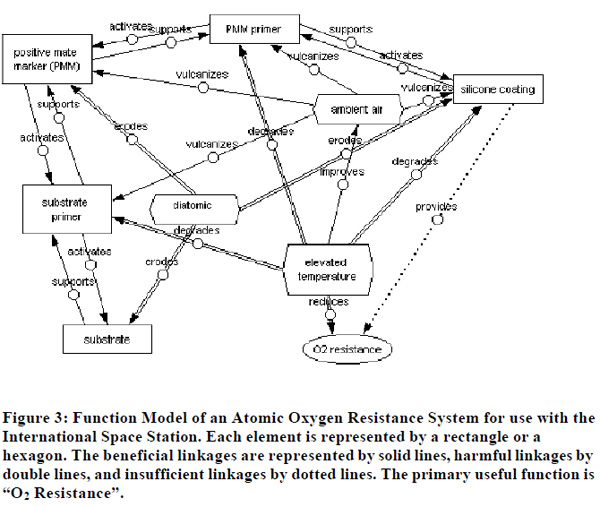Leaning on TRIZ
Editor | On 19, Jun 2004
by
Michael S. Slocum, Ph.D., T.Sc., M.B.B.
Vice President of Research and Development
Breakthrough Management Group
anything new.â€
–Albert Einstein (1879-1955) “Discovery consists in seeing what everyone else has seen and thinking what no one else has thought.â€
–Albert Szent-Gyorgi, 1937 Nobel Prize in Physiology and Medicine
The Lean Methodology may be applied in order to reduce waste in a system. Sometimes this waste may take the form of non-value added operations present in a system. The application of a process map, value stream map or a flow-diagram may be used to help identify those non-value added operations. This process, although at times may be difficult, is usually academic. The difficulties arise when an attempt to eliminate the nonvalue added operation from the system takes place.

Frequently, the non-value added operation in question provides some type of indirect benefit to the system—which is the reason it was added in the first place. The negative effect may be greater than the positive and therefore the operation becomes a target for elimination, the question becomes, how do we keep the benefit of the operation once it is removed? The Theory of Inventive Problem Solving can help in this area. The first step would be to create a Function Model of the system. The Function Model is created based on cause and effect relationships between the elements of the system. The primary useful function of the system is an excellent starting point for the creation of the Function Model. Several questions are asked, in turn, and the answers to these questions provide the balance of the model generation. The questions are called control questions and they are as follows:
Does the selected function produce any other functions?
Is the selected function produced by another function?
Is the selected function counteracted upon by another function?
As these questions are answered, the other elements of the model are added as well as links between the elements. The links are established as either being beneficial or harmful. It is also possible for an element in the model to provide benefit as well as harm. This is a possible example of a non-value added operation that provides some indirect benefit to the system. It is also possible that an element does nothing but counteract a benefit or create harm. In this case, the element should be eliminated and there is no useful function to preserve. The elimination of this type of element is accomplished with little difficulty. In the first case, the element is causing harm but also providing some benefit. In this case the benefit should be preserved without the harmful effect. This complicates the elimination of a non-value added operation. In the TRIZ methodology this operation is called “trimmingâ€. Trimming is utilized to remove the element causing harmful effects or counteracting useful effects. In this case the element should be trimmed in order to remove harm but there is a useful feature that will be eliminated as well. In this instance, a contradiction has been identified. The contradiction takes the following form:
“I would like to eliminate X but I can’t because benefit Y should be preserved.â€
This construction follows the form of a Technical Contradiction. The Technical Contradiction is resolved using the simple four-step algorithm shown in Figure 2.

The contradiction form is the entry point for the algorithm at step1. The contradiction identified must then be characterized using the 39 Parameters from Contradiction Matrix Theory. The parametric contradiction then becomes input criteria for the Contradiction Matrix.1 The output of the matrix is a subset of the 40 Innovative Principles. These principles are then utilized by the practitioner to generate specific solutions to the original problem using abstraction. This empirically-based approach to contradiction resolution can greatly assist in the elimination of a non-valued added operation that provides some indirect benefit. This enables the operation to be removed without losing the reason for it originally being added—for these cases where there was a reason to begin with.


The analysis would indicate that the operation “Elevated Temperature†should be eliminated from the system as it produces harmful effects on the Substrate, Primer, and Silicone Coating; but cannot be eliminated because of the beneficial interaction of the “Elevated Temperature†and “Ambient Airâ€. In fact, without “Elevated Temperature†as part of the operation, there would be no resistance to diatomic oxygen. Therefore, the element needs to be trimmed but this poses a difficulty. Application of the Lean methodology alone would not shed any light on how this element could be removed from the system. An application of Contradiction Theory allowed the team to identify the limited-value condition and then characterize the contradiction associated with its removal. The following construction was used: “We would like to eliminate the use of elevated temperature but we can’t because it helps the compounds to cure properly.†This became our input for the resolution of the contradiction using TRIZ according to the algorithm indicated in Figure 2.
Hopefully, the integration of Lean and TRIZ will be seen as the combination of two complementary methodologies. Each may be used to increase the benefit of using the other. For these reasons, I would strongly encourage their combined use.
About the Author: Dr. Michael S. Slocum is Vice President of Research and Development at Breakthrough Management Group. He has published over 80 articles and lectured at nearly 60 conferences. Dr. Slocum was the recipient of the UCSD CONNECT Most Innovative New Product of the Year Award in 1999. Dr. Slocum is an expert in Structured Innovation (TRIZ) and the integration of advanced methodologies. Dr. Slocum is a Fellow of the Royal Statistical Society of London, England and the editor of The TRIZ Journal (www.the-trizjournal.com).

